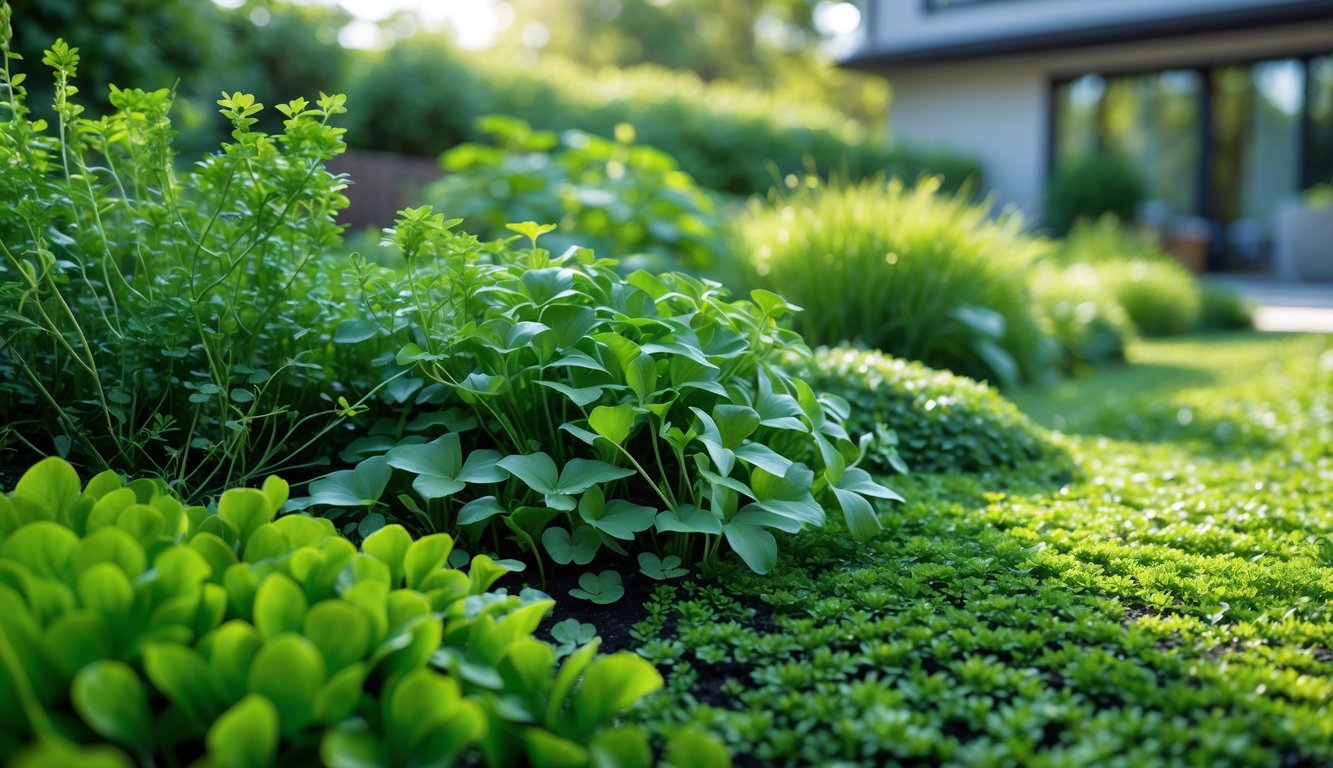
Drought-Tolerant and Water-Saving Options
Honestly, watering and mowing all summer just drained my wallet and my patience. Everyone’s talking about swapping out turf—costs and water bills are out of control, and drought-resistant plants are just easier.
Xeriscaping Foundations
I still can’t believe how much I spent on boring grass while xeriscape fans skipped the drama. Xeriscaping isn’t just rocks and cacti (unless you want that). It’s about picking plants that actually want to live where you are.
I grouped stuff by water needs—suddenly, the yard looked intentional instead of random. Native perennials and mulch saved me from watering bans and gave me actual curb appeal.
Supposedly, a good xeriscape can cut water use by 60%. My bill didn’t drop overnight, but it’s going down. Backyard Boss says even if you mess up at first, you’ll still avoid the worst drought disasters.
Sedum and Succulents
Let’s just start here: I’ve murdered more succulents than I care to admit. Instagram tips, YouTube hacks, whatever—doesn’t matter, they rot anyway. But, sedum? That stuff’s on another level. Forget those dinky pots—sedum sprawls into these thick, bouncy mats that basically babysit themselves. There’s a reason every green roof is just sedum on sedum. My neighbor’s front strip? Sedum jungle. I haven’t seen him weed anything since 2021. Maybe he’s hibernating.
Honestly, you plop it in, maybe yank a weed if you’re feeling ambitious, and then just leave it. Sedum laughs at the sun and doesn’t crisp up in August like my so-called “drought tolerant” grass did. Lawn Love claims sedum can handle garbage soil where other ground covers just give up and die. I believe it. Water it a bit at first, then ignore it. If you’re sick of hoses, timers, or buying fertilizer you forget to use, this is where you stop pretending you care.
Buffalo Grass and Blue Grama
Buffalo grass gets hyped as the scrappy hero of lawns, and I’ll admit, it’s not all talk. I threw down a patch, watered it like twice, and it’s still here. Weeds? Fewer than before, except for the neighbor’s cat, who treats it like a personal spa. Blue grama’s the same vibe—prairie grass, no drama, and it doesn’t look as weedy as I feared.
Supposedly, you cut water use by 60-70% with these, which sounded like a scam until my irrigation bill dropped. Buffalo grass is weirdly tough—kids, dogs, random foot traffic, it just keeps going. JourneymanHQ swears it’s durable and needs basically nothing. If you want neon green, though, you’re out of luck. It’s more “gently faded wheat” most of the year. I kinda like it.
Turf snobs might sneer, but my blue grama patch survived the last drought and looked smug about it. If you try it, overseed the bald spots—because you’ll always have bald spots, and chasing perfection is for people with nothing better to do. My bill’s under $30, so I’m not complaining.
Ground Cover Plants for a Lush, Green Look

Why does picking ground cover feel like gambling? Nobody warns you about squirrels, plant thieves, or the dandelion uprising. If you want to avoid constant mowing and spending money on stuff that doesn’t work, details matter. The right ground cover means you trap moisture, never mow, and step on herbs instead of weeds. Sometimes I think that’s the only real victory.
Creeping Plants
My neighbor swore skipping fescue would ruin her yard, but honestly, creeping plants like ajuga reptans just take over. Blue spikes in spring, leaves that look like marble—no apologies. Ajuga reptans and veronica speedwell choke out weeds better than my robot vacuum ever did (and that thing’s loud). People act like tall plants are always tougher. Nope. Veronica hugs the ground and throws out blue or white flowers before you remember to fertilize.
Dichondra’s the one everyone mistakes for clover. It’s not. It needs sun, shrugs off puddles, and slides between stepping stones so my shoes stay clean. Anyone still throwing down grass seed must not have checked their water bill or read about how much time they’re wasting. The Spruce once said you can skip most hand-watering with these. Fewer bugs, fewer complaints, except the time the UPS guy tripped (I warned him).
Steppable Ground Covers
Let’s talk trip hazards. Mondo grass? It doesn’t care. Every nursery calls it “steppable,” and they’re not lying. Ophiopogon japonicus—who comes up with these names?—looks like a tiny fountain, stays green all year, sun or shade, whatever. Mazus reptans is this blue carpet until the neighbor’s kid crashes his scooter through it.
Corsican mint, though—don’t expect it to smell like toothpaste. If you keep it away from ants and under stepping stones, it handles more foot traffic than creeping thyme ever did. Planted right, they smother weeds, and sometimes I find random junk in the mats because they’re that thick. But, if it’s soggy and shady, moss sneaks in and pretends it belongs. Annoying.
Evergreen Varieties
Here’s what gets me: people ignore evergreen ground covers. Ajuga reptans and mondo grass (always the black kind, not “dwarf”) stay green in January when everything else looks dead. I keep checking for frost damage; never happens. Most evergreens pay for themselves—some turf magazine ran a five-year test and said evergreens cut irrigation by 35% over cool-season grasses. I buy it.
Hellebores and liriope are great, but honestly, I only trust them under shrubs. Evergreen sedum and ajuga? They keep things green all year, even when I forget to rake. Plus, leaf blowers just skate over them—less cleanup. I’d take these over weeds, mower battles, or whatever the neighbor’s cat drags in. For more ideas, check this ground cover list.